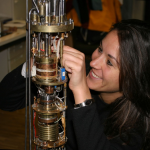

- Photon Transport in a Bose-Hubbard Chain of Superconducting Artificial Atoms
G. P. Fedorov et al., Phys. Rev. Lett. 126, 180503 (2021) - Path-Dependent Supercooling of the
He3 Superfluid A-B Transition
Dmytro Lotnyk et al., Phys. Rev. Lett. 126, 215301 (2021) - Superconductivity in an extreme strange metal
D. H. Nguyen et al., Nat Commun 12, 4341 (2021) - High-Q Silicon Nitride Drum Resonators Strongly Coupled to Gates
Xin Zhou et al., Nano Lett. 21, 5738-5744 (2021) - Measurement of the 229Th isomer energy with a magnetic micro-calorimeter
T. Sikorsky et al., Phys. Rev. Lett. 125 (2020) 142503
Diverse influences of hyperfine interactions on strongly correlated electron states
Femke Bangma, Lev Levitin, Marijn Lucas, Andrew Casey, Jan Nyeki, Ineke Broeders, Aaron Sutton, Bohdan Andraka, Stephen Julian, John Saunders, Alix McCollamThe motivation to develop materials for quantum technologies has put exploration of novel quantum states of matter at the focus of several research fields, with particular efforts towards understanding and controlling the behaviour of quantum entangled and other strongly interacting electronic states. Experimental investigation is of primary importance, but requires measurements at ultra-low temperatures where the quantum states of interest have long lifetimes. Under these conditions, low energy interactions, such as hyperfine or nuclear exchange interactions, become relevant, and can modify electronic ground states and their associated excitations in multiple ways that are not well understood or characterised. In this work, we use a recently developed magnetic susceptibility technique, compatible with ultra-low temperatures and high magnetic fields, to probe the influence of nuclear interactions on superconducting and multipole ordered ground states in the strongly correlated electron system PrOs4Sb12. We find that the multipole order develops a novel, entangled nuclear-electronic character at the lowest temperatures, which significantly modifies the phase boundary and leads to a nuclear quantum critical point. In the superconducting phase, we find that hyperfine interactions suppress superconductivity in a manner that provides evidence for superconducting pairing mediated by crystal field excitations. Our results on PrOs4Sb12 experimentally establish a new type of non-magnetic, nuclear quantum critical point, and give revealing insight into a highly unusual superconducting state. They also demonstrate more generally the feasibility of exploiting hyperfine interactions as a tuning parameter for experimental creation and investigation of a variety of quantum states and phenomena in correlated electron materials.
arXiv.2305.17088
doi: 10.48550/arXiv.2305.17088
arxiv: https://arxiv.org/abs/2305.17088















